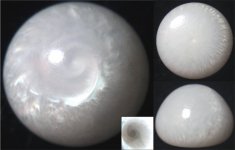This miraculous 'pearl from the eye of a Nautilus' was sold to a London jeweler and subsequently sent to GemLab for certification (my assumption based upon GemLab director Thomas Hainschwang's description of an odd specimen with 'swirl' received just prior to our meeting in Tucson last February).
I assume it failed certification, as it has resurfaced on the seller's website.
This is a calcareous gastropod operculum (
LINK to the authority on the subject), polished up a bit. The seller has reduced his price to a modest $20,000 US. But it is a full 30 carats.

